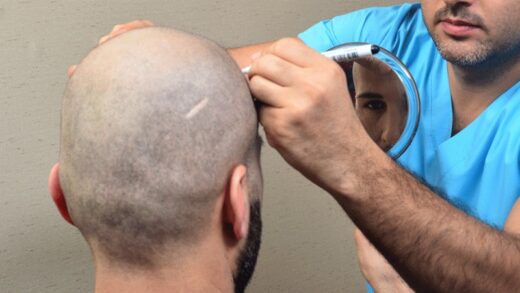The problem of crusting after hair transplant can be uncomfortable for patients who want rapid recovery after the hair transplantation procedure. You can find details about the scaly appearance that occurs on the scalp after the operation and how to solve it from our content.
What Causes Crusting After Hair Transplant?
There are two basic methods used in hair transplantation methods. In process performed with FUE and DHI techniques, hair follicles are taken from the donor area and transplanted to the receiving area. In the process, small incisions are made on the scalp in both the donor and receiving areas. At the stage of incisions, damage occurs on the scalp, although it is minimal. Small shells are formed in the incision places due to damage to the scalp after the process. The less bleeding that occurs in the receiving area, the less shell formation will be.
Within the first 24 hours after the operation, crusts will form on your scalp. Crusting in the first 24 hours can also be accompanied by swelling and redness. You can confuse the shells with pieces of skin that dry out after surgery. However, you can easily notice the skin parts when spraying the care spray that you should use after the hair transplantation operation. Be careful not to tear these skin fragments. Because the resulting skin fragments should not be damaged. The use of shampoo after hair transplantation will further speed up recovery process. However, these should be use with the recommendation of a doctor.
How to Remove Crusts After Hair Transplantation?

Crusting after hair transplantation is an indication that the damage to the scalp has been repaired. Itching can be see after hair transplant. However, you should not scratch your head so as not to damage the newly planted grafts. Contact with the processing site may dislodge the grafts. In addition, it can cause empty spots on the scalp.
It is not recommended to remove the shells from the hair. To soften the shells without damaging the hair, you can soften the shells with warm water. Shells heated with warm water can be left for about 10 minutes and apply conditioner. The shells under the conditioner will now become completely softened. Then you can massage the shells on the scalp with gentle movements. After the massage, the shells will separate from the scalp by themselves. Be careful not to use your nails in the hair washing process after hair transplantation. Shells dug with nails can cause the formation of infection. This can also have a bad effect on the outcome of the operation.
When the washing is finished, you can wipe the scalp with a soft towel. By performing this routine, you can get rid of the problem of crusting. Crusts begin to fall ten days after the operation.
Crusting After Hair Transplant: What Can You Do?
Precautions you can take as long as the crusting of the scalp continues:
- Don’t scratch your scalp.
- Do not attempt to remove the shells with your hands.
- Avoid touching the graft area.
- When you scratch your scalp, you can cause the grafts to dislodge.
- Try softening crusts as recommended by your doctor.
- Wait at least a week for the shells to fall out on their own.
Result
After hair transplantation, you can make the applications recommended by the doctor for crusting. Crusting occurs as a result of damage to the scalp. These can be uncomfortable for patients. Hair transplantation specialists recommend waiting 10 days. Usually after 10 days, the shedding begins. In case of no spillage, you should consult your doctor.
You can make an appointment with Erdem Clinic for free hair transplant examination.
Frequently Asked Questions
How do I get rid of the crusting after hair transplant?
It is important to clean the crusts formed by leakage of blood and bodily fluids after hair transplantation. It is possible to clean these crusts formed by softening and washing with lotion. From the day recommended by the doctor, it is necessary to regularly carry out lotion washing every day. Usually the crusts are completely cleaned within two weeks.
Is scabbing normal after hair transplant?
You may see crusting on your scalp after hair transplant. That’s normal. During the procedure, it occurs as a result of bleeding of the hair follicles removed. In about two weeks, the crusting completely passes.
Does hair grow through scabs?
Your hair won’t grow in scar tissue. Because it is not possible to grow hair in a wound place. In the form of damaged skin or a scar, the likelihood of new hair growing is almost non-existent.